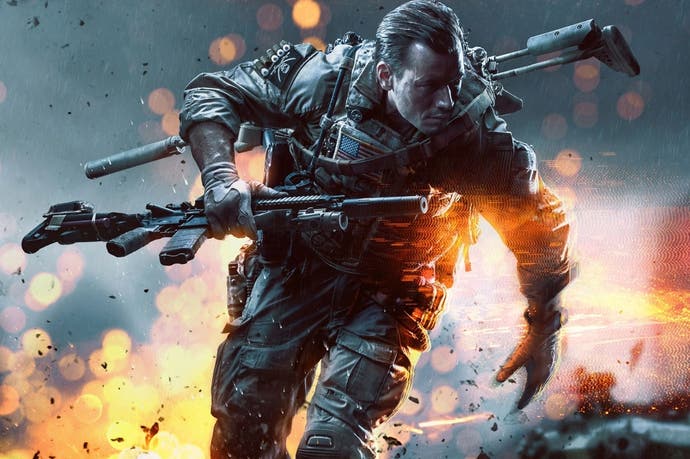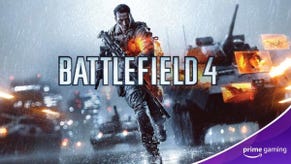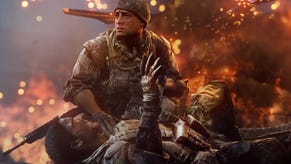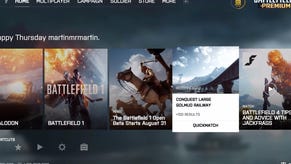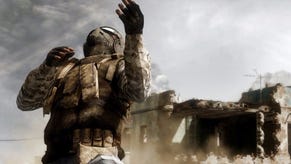Next-Gen Face-Off: Battlefield 4
Retail hardware, final code - the complete analysis.
After running our preview comparison of Battlefield 4 exactly one month ago, it was startling to see how great the advantage proved for one platform in particular; a shocking signifier of the form all future next-gen comparisons might take. The PS4 had the higher internal resolution, a considerable performance lead in motion, and the addition of extra effects such as horizon-based ambient occlusion entirely missing on Xbox One. But now, with the retail releases out in the wild, we can see to what extent this disparity is set in stone, and whether DICE's implication of further tweaks to the Xbox One release actually makes up any ground.
For the sake of absolute thoroughness, we can confirm any such change doesn't extend to the resolution issue. If you're buying the PS4 version, you're getting a 1600x900 image scaled to whichever output you'd prefer, while the Xbox One trots behind with a 1280x720 framebuffer that, to be blunt, has an impact on overall visibility on some of the game's bigger multiplayer maps.
In motion, it's the Xbox One version that suffers from the greater temporal aliasing - a flicker artefact on thin geometry and power-lines while panning - but also a general muddying of enemy outlines on the horizon. A post-process anti-aliasing method is in place for both versions, but it's simply not enough to pull the Microsoft release out of the muggy mire as far as image quality goes - it stands as a real shame.
As addressed in our editor's blog Q+A, there are three specific factors that influenced the image quality of the preview build comparison, and each has been put to rights for the final release. Firstly, the brightness of the game ships at 50 per cent as default, rather than the stock 30 per cent set at the Stockholm event, meaning the image produced here now lines up precisely with the PC's. Secondly, the black crush previously seen on Xbox One is gone for the consumer-side product, meaning the colour space is now a much closer match to the PS4's. For a close look at the results in any combination, feel free to check out our head-to-head comparison videos below, or our 76-strong image comparison gallery.
"There are image quality improvements on Xbox One since we last saw the game, but the resolution and performance differentials remain in full effect on the final code."
Alternative comparisons:
Interestingly, the third issue is where we see an active design change being made. As is the case for Xbox One games such as the recent Call of Duty: Ghosts, some titles rendering at below 1080p make use of a hardware upscale that artificially sharpens the image. This produces a prominent halo effect around around details - the idea being that it adds "pop" to some elements, but with the largely unwanted side effect of emphasising aliased edges.
Thankfully for Battlefield 4, these sharpening artefacts have been entirely removed for its final release on Xbox One. The aliasing issues still persist in a typical manner for a 720p game, but not in such a vicious capacity as was once the case. This doesn't excuse the Xbox One's image quality by comparison to the 900p output on PS4, but it's one less point of concern if this is the only version you intend to buy.
Moving past image quality matters, we're pleased to see HBAO reinstated on Xbox One as promised by DICE's tech guru Johan Andersson, who specifies that it uses the "same tech as PS4/PC". In practise, the effect is most easily spotted as a light shade around a player's gun when approaching a wall, and pulls the Xbox One release in line with Sony's platform as far as effects, lighting and shadows are concerned.
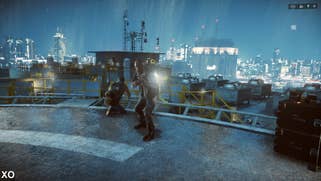
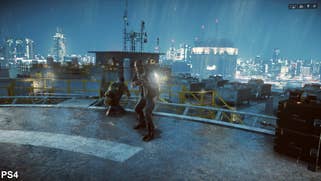
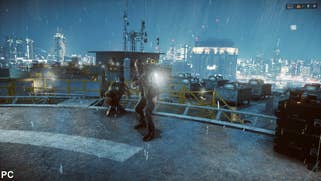

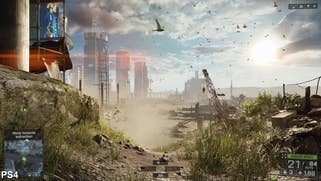

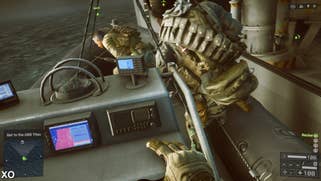
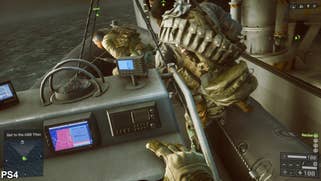
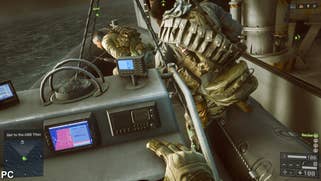
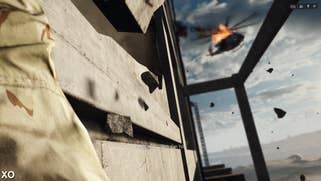
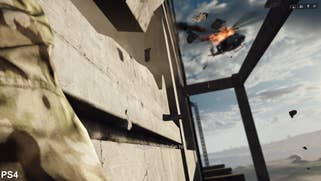
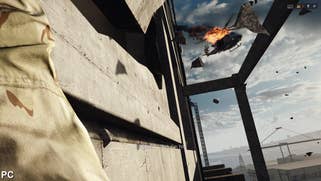
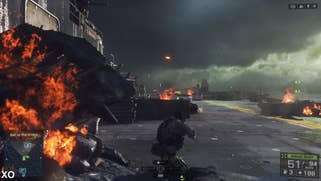

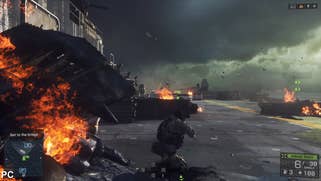
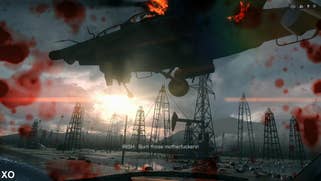
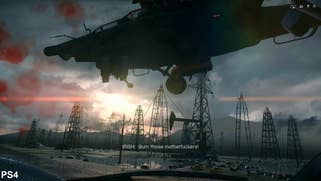
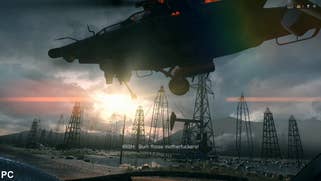
Sadly, both next-gen platforms fall short of toppling the PC's ultra quality shadow setting. The difference is nuanced, and has the gaps in grills and meshes play out in shadow form across walls, as well as other areas filled out with more light-path detail. A filtering cascade on shadows is also noticeable - barely - on PS4 and Xbox One as you travel up sharp inclines such as stairs, but with motion blur in constant effect this is a tricky one to spot in motion.
As far as texture and world detail go, normal mapping on the ground is identical in quality with the PC's maxed-out setting, even on larger areas where you might expect a compromise. However, draw distances for plants and geometry are noticeably better-rounded on PC: appearing in higher density when up close, we see buildings rendered in during cut-scenes that simply don't manifest on next-gen platforms. This is backed up by a more liberal use of particle effects on PC around explosions, and while alpha for fire is comparable up close, flames in the distance suffer from a downgrade in quality on PS4 and Xbox One.
But with all else being equal in the final build, image quality stands out as the biggest differentiator in terms of defining each console's look. Neither can match the upscale-free 1080p output of the PC for handling tiny water shader details - appearing especially blurred over as a result on Xbox One. It's also curious that both platforms introduce a more aggressive depth-of-field layer during scripted events, where the PC is left largely unaffected.
"Revisiting the single-player campaign across a wider range of levels reveals that the gap between Xbox One and PS4 has widened since our preview - and it's not good news for the Microsoft platform."
One stone left unturned is a frame-rate analysis of Xbox One's multiplayer mode - there were network problems on the first day of our Stockholm visit, meaning we could only look at the campaign mode. The PS4 version clearly struggled though, and likewise, for fully saturated 64-player Conquest Large games what we get here is a frame-rate that falls far below 60fps. Flood Zone gives us the biggest drop, going down to 30fps while swimming through a submerged ground floor of a building, but the overall experience across a breadth of levels is predominantly between 40-50fps on both Xbox One and PS4. Much of this has to do with the destruction dynamic, where walking through the debris of a levelled skyscraper in the Siege on Shanghai stage gives us a constant 40fps, for example.
Even with the massively dialled down internal resolution on Microsoft's platform, it's telling that these frame-rate drops remain consistent across both sets of hardware, indicating the bottleneck may be in the utilisation their multi-core Jaguar CPUs. By comparison, the PS4 fares a little better based on our experiences; though the nature of Battlefield's multiplayer games is often too chaotic and variable for a fair, like-for-like tests to be feasible. Even so, the key takeaway here is that those looking for the most fluid experience will need to stick with smaller Team Deathmatch games.
To settle the performance debate once and for all though, we defer to our matching tests of the campaign mode. While more corridor-heavy by design, the Frostbite 3 engine is pushed to its extremes during the sandbox-style battles across Baku, plus a number of effects-heavy in-engine cut-scenes. The Xbox One scrapes a singular lead during an early set-piece, involving the floor giving way to a sea of alpha and particle effects - but this is an anomaly given what follows.
For every other sequence, we see a consistent delta of 10fps in the PS4's favour; from the docking of a rainy, battle-torn Singaporean beach to the ripping in half of an airship carrier. At its peak, the PS4 takes up to a 16fps lead also, leaving the Xbox One stuttering along in the face of alpha effects during the Baku mission's towering explosions. Let there be no doubt that the PS4 has a huge advantage in frame-rate and overall smoothness of control, then - just one which doesn't satisfactorily translate to the multiplayer side.
"While PlayStation 4 bosses the single-player campaign, the gap seems to close in multiplayer, where both platforms seem to have genuine issues sustaining 60fps."
Alternative analysis:
It's worth mentioning that crashes and bugs have been a regular fixture of our online experience on both consoles so far. These are perhaps expected launch-day blues; one major nuisance is the sudden crashes to the OS menu when requesting a respawn, though our experiences since yesterday's patch 1.03 suggest this issue has been addressed. Sound glitches are still a bother on bigger stages like Golmud Railway though, where all ambient noise such as engine whirs, footsteps and the rolling tide cut out for no apparent reason. The short-term fix for this is to enter third-person view while in a vehicle, which seems to re-mix the sound - though it's clear this still needs attention.
Battlefield 4: the Digital Foundry verdict
In all, it's our first chance to see Battlefield 4's multiplayer mode in action on Xbox One, and to witness either version of the game running on final retail hardware. On the visual side, HBAO is indeed added to the Xbox One version, as promised by DICE following its omission in the Stockholm build. However, the divide in internal resolution - which remains at 900p on PS4 compared to the straight 720p on Xbox One - is the big sticking point, even with the removal of the Xbox version's sharpening filter which amplified the aliasing. Put simply, the assets and effects are identical for each next-gen platform, but the added pixel definition on PS4 spares it from the distracting edge-crawl on thin objects that proves to be an issue on the Microsoft side.
Elbowing into the tussle is, as always, the PC version with its higher-grade particle and alpha effects, superior object draw distance and more refined shadow detailing at ultra settings. But it must be commended just how much of this maxed-out experience translates to next-gen platforms. The textures on PS4 and Xbox One are equal to the PC's highest, and water shaders carry over as-is, where the current-gen versions really show us the plain, pared-back alternative. It's a very solid effort in this sense, and can only get better as DICE's understanding of the hardware grows.
The PS4's strong performance lead is the real clincher though; a wide 10fps margin flaring up for most of our campaign mode tests. The comedown hits, however, once you realise that neither platform can pull off a straight 60fps during the larger Conquest multiplayer maps, where most of the fun is to be had. Regardless, a clear-as-day recommendation still goes to the PS4 version, and while there are glitches on both consoles that need to be addressed, the embracing of seamless, behind-the-scenes updates should at least ease some of Battlefield 4's growing pains.
DICE has just announced new hardware to help squash those Battlefield 4 bugs.
